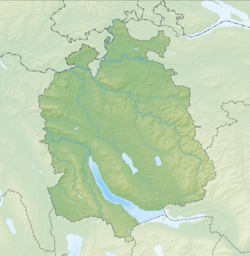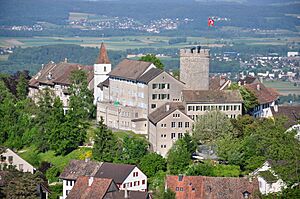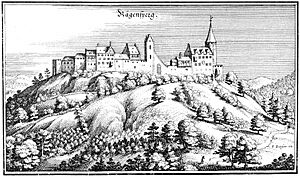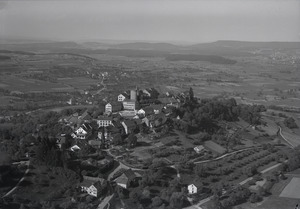Regensberg facts for kids
Quick facts for kids
Regensberg
|
||
|---|---|---|

Regensberg pictured in 2010
|
||
|
||
| Country | Switzerland | |
| Canton | Zurich | |
| District | Dielsdorf | |
| Area | ||
| • Total | 2.37 km2 (0.92 sq mi) | |
| Elevation | 617 m (2,024 ft) | |
| Population
(Dec 2020 )
|
||
| • Total | 459 | |
| • Density | 193.7/km2 (501.6/sq mi) | |
| Postal code |
8158
|
|
| Surrounded by | Boppelsen, Buchs, Dielsdorf, Oberweningen, Schleinikon, Steinmaur | |
Regensberg is a small town, also called a municipality, located in Switzerland. It is part of the Dielsdorf District in the canton of Zurich. You can find Regensberg just west of the town of Dielsdorf, sitting on a hill that is part of the Lägern mountain range. This hill is about 617 meters (2,024 feet) high.
Contents
Regensberg's Rich History
Regensberg was first built as a fortified settlement on a hilltop around the year 1245. It was founded by a nobleman named Baron Lüthold of Regensberg. The town's defenses included a tall, round tower that is 21 meters (69 feet) high. This tower was built later, in the 16th or 17th century. There was also a very deep water well, about 57 meters (187 feet) deep. The main church, Regensberg Reformed Church, was first built in the 13th century and then rebuilt around 1540.
Early Conflicts and Changes
In the mid-1200s, the Barons of Regensberg had disagreements with the city of Zurich. They also argued with the Habsburgs about who should get the land of the Kyburg family, who no longer had an heir. These arguments led to a war in 1267 between the barons and the combined forces of Zurich and the Habsburgs. The barons lost this war, and their power quickly faded over the next 50 years. In 1302, they sold Regensberg to the Habsburgs.
Under the Habsburgs, Regensberg grew into a market town, which is a town where people come to buy and sell goods. The Regensberg Castle became the main political center for the area that is now the Dielsdorf district. The Habsburgs set up a local government called an Amt Regensberg, led by a person called a Schultheiß.
Zurich Takes Over
In 1409, a Habsburg duke named Frederick IV had to give Regensberg to the city of Zurich as a payment for a debt. However, Zurich did not fully own the town until 1417. Zurich then created a new local government called an Obervogtei in Regensberg. This government ruled over thirteen villages nearby.
In 1540, the upper part of the castle caught fire. Luckily, the lower gates and the main tower (called a donjon) were saved because a deep ditch separated them from the fire. The upper castle was rebuilt the very next year. During a time of religious change called the Reformation in Zürich, an old abbey in Zurich was taken down. Stone blocks and two bells from that abbey were brought by ox cart to Regensberg to help rebuild its church.
Modern Times and District Changes
After the old Swiss government system ended in 1798, Regensberg became part of the Bülach district. In 1803, it became the capital of its own smaller district. This district grew in 1831 to become the larger Regensberg district. However, in 1871, the capital of the district moved to Dielsdorf. Regensberg then became an independent municipality within the Dielsdorf district.
One interesting old building in Regensberg is the "Rote Rose" house. It is a half-timbered house, meaning its wooden frame is visible on the outside, and it dates back to 1540.
Notable People from Regensberg
One important person born in Regensberg was Eberhard II, around 1170. He became a very important church leader. In 1196, he became the Bishop of Brixen, and in 1200, he became the Archbishop of Salzburg. Eberhard helped create several new bishoprics (areas led by a bishop) under Salzburg. He also founded churches and a monastery. Eberhard passed away suddenly in 1246.
Regensberg's Geography
Regensberg covers an area of about 2.4 square kilometers (0.9 square miles). A large part of this land, about 34.5%, is used for farming. Even more, 56.7%, is covered by forests. The remaining 8.8% of the land is where buildings and roads are located.
Regensberg's Population
Regensberg has a population of 459 people. About 16.3% of the people living in Regensberg are from other countries. Over the last ten years, the population has slightly decreased. Most people in Regensberg, about 93.0%, speak German. French is the second most common language, spoken by 1.6% of the people, and English is third, spoken by 1.2%.
In the 2007 election, the most popular political party was the Swiss People's Party. They received 31.1% of the votes. Other popular parties included the FDP (17.9%), the Green Party (14.5%), and the SPS (13.7%).
Looking at the age of the people in Regensberg, children and teenagers (ages 0–19) make up 23.8% of the population. Adults (ages 20–64) make up 65.9%, and seniors (over 64 years old) make up 10.3%. A high number of adults in Regensberg, about 86.8%, have completed either high school or gone on to higher education like a university.
Regensberg has a low unemployment rate of 1.48%. In 2005, there were 18 people working in farming and related businesses. Fourteen people worked in manufacturing and construction. The largest number of people, 121, worked in the service industry, which includes jobs like retail, healthcare, and education.








